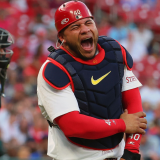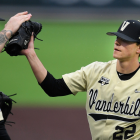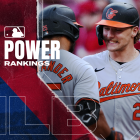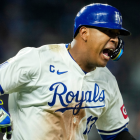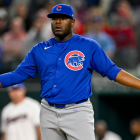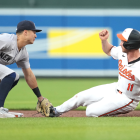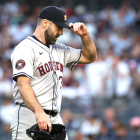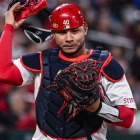
Major League Baseball's amateur draft is scheduled to begin on Sunday, July 11, or less than five months from now. With high school baseball already underway, and major college baseball conferences cranking up later this week (you can find an extensive college baseball preview here from CBS Sports' Dayn Perry), this presents as good of a time and as good of an opportunity as any to preview the upcoming draft class.
Below, you'll find the preseason top 50 -- that is, 50 players who we deemed worth including based on their combination of potential and expected draft slot. (The player ranked No. 5 might not go fifth overall, but they should go somewhere in the range.) These rankings are formed based primarily on conversations with scouts, analysts, and other front office types, as well as firsthand observations and historical data.
A lot can change in five months' time, so view it for what it is: a snapshot of the present attitudes and evaluations on these players.
1. Jack Leiter, RHP, Vanderbilt
Leiter's freshman year (all 15 innings of it) saw him post a 1.72 ERA and a 37 percent strikeout rate while utilizing an improved arsenal. His fastball can get into the mid-90s and looks good on a Trackman readout, his top-down curveball is devastating, and he has a quality slider. He's since added a cutter, and is said to be dead set on improving his changeup. Leiter has more than a deep well of pitches to draw from; he receives ample praise for his athleticism and his intelligence, with neither coming as a surprise given his bloodlines (his father, Al, and uncle, Mark, combined to pitch in 30 big-league seasons). He also stands to benefit from the era in which he pitches: smaller starters (he's listed at 6-foot) are now viewed more favorably because of the flat plane they create at the top of the zone, and because of declining workload expectations. So long as Leiter stays healthy and doesn't walk the park, he's a real candidate to go No. 1.
Jack Leiter, Filthy Curveballs paired with a 96mph Fastball.
— Rob Friedman (@PitchingNinja) February 25, 2020
Starts off where he left off (K'ing the side). pic.twitter.com/XTCkX5rSoQ
2. Jordan Lawlar, SS, Dallas Jesuit HS (TX)
The most commonly used comparison with Lawlar is to Bobby Witt Jr., a fellow Texan who was drafted second by the Royals in 2019. As with Witt, Lawler's upside should obscure his relative seniority (he'll turn 19 before the draft). He has the requisite hands, arm strength, and footwork to remain at the shortstop position for the long haul. At the plate, he marries a quick bat with a frame that bodes well for future plus power. Lawlar's boosters believe he could possess five tools that grade as above-average or better at his peak, making him a regular (and plausible All-Star) at a premium position. It's a strong year for high-school shortstops, and Lawlar currently looks like the best of the bunch.
3. Jud Fabian, OF, Florida
The most curious aspect of Fabian's game is that he bats righty and throws left; he's a "wrong-way guy" in scouting parlance. Whether it's a coincidence borne from a small sample, or a product of a deemphasized dominant hand, history hasn't been kind to the profile. Rickey Henderson was one; Ryan Ludwick and Cody Ross were, too. After them, you have to stretch to find a recent, decent career from a wrong-way outfielder -- and that's the replacement-level brigade of Guillermo Heredia, Collin Cowgill, and Joey Rickard. Rest assured, Fabian seems likelier to join Ludwick and Ross' tier. His relative youth (20 until September) and his track record of hitting the ball hard against SEC-quality competition should endear him to model-guided teams. Fabian has whiffed in more than a quarter of his trips to the plate (including a stint in the Cape Cod League), though some scouts believe he'll get the strikeouts under control as he slows down the game. He'll likely begin his pro career playing center field, but his lack of plus foot speed could force him into a corner before long. The most probable outcome, then, has Fabian turn into a solid regular whose power represents his only plus tool.
4. Kumar Rocker, RHP, Vanderbilt
Rocker established himself as a household name (or as close to one as a college baseball player can get, anyway) during the 2019 super regionals, when he struck out 19 batters in a no-hitter against Duke. Since (and even before) then he's been considered a candidate to go near the top of this draft. Rocker has some tantalizing qualities. His fastball sits in the mid-90s, and his slider is one of the most aesthetically pleasing chase pitches in the class. He already possesses big-league physicality, with a height-weight combination (6-foot-5, 245 pounds) that resembles those of Lance Lynn and Brad Keller. The downside to him already looking the part is that teams have concern about his long-term body maintenance. There are other, more pressing considerations to navigate here as well. Despite the raw velocity and improving metrics, his fastball's results have underwhelmed dating back to his high-school days. Some scouts have concerns that his slider won't be an effective in-zone pitch for him at the big-league level because of its movement patterns. There's also the matter of his mechanics: a high back elbow and an oft-late arm rob him of precision and could contribute to additional wear and tear on his joints. Some of this criticism is a product of Rocker's celebrity; some of it is genuine worry that teams have to balance. He's still all but certain to go early on, but don't be surprised if he's the second or the third college pitcher to come off the board.
5. Marcelo Mayer, SS, Eastlake HS (CA)
Mayer, a Southern Cal commit, is regarded as the second-best shortstop in the class. He has a defensive toolkit to bank on, as it should allow him to remain at the six. His offensive profile is a little more speculative. He has a projectable frame (6-foot-3, 188 pounds), but his left-handed swing is going to require work if he's to develop pop. Even if his bat plays light, he should offer enough value to hold down a starting job someday.
6. Adrian Del Castillo, C, Miami
Scouting the stat line is a bad habit to take up, but you would be correct to look at Del Castillo's production at Miami (.336/.430/.571 with 39 extra-base hits and 11 more walks than strikeouts) and conclude he's a skilled hitter. He has a keen eye and a good feel for contact thanks to a handsy, line-drive swing that sees him keep the barrel tight to his body. He has above-average juice, too, though he's more of a hitter with power than a power hitter. Del Castillo's future employer will have to decide if they want to mess with what works by asking him to trade contact for slug. Said employer will also have to figure out where to play him. Some scouts are convinced he's going to end up in left field or at first base; others want to see if his new commitment to the one-knee, Tony Pena-inspired stance will improve his receiving. Either way, Del Castillo's bat gives him a high floor, and he might come off the board even earlier than this.
7. Kahlil Watson, SS, Wake Forest HS (NC)
Put a star next to Watson's name because there's a chance he becomes one. In addition to being a capable shortstop and runner, he has one of the prettiest and most mature swings in the class. Watson creates oodles of torque, a byproduct of the separation he achieves between his upper and lower halves during his load. The resulting explosivity permits him top-end hand speed and a bat path that should lend itself to above-average power production. Watson will need to improve his approach to maximize his output, and there's a chance any added muscle will force him to another position. There's a lot to like here all the same, and it seems certain he never steps foot on NC State's campus.
8. Henry Davis, C, Louisville
Don't sleep on Davis as a dark horse to go in the top five. He'll enter the season having appeared in 59 collegiate games (including the Cape Cod League), during which he recorded 22 strikeouts and 21 walks. Davis is short to the ball, utilizing a compact swing that sees him wrap his barrel and keep it tight to his body. He's strong and sturdily built, yet he seldom swings and misses. When he does engage, he frequently makes hard contact, mostly on a line. Behind the dish, he has experience catching pro-level arms, and he has near-elite arm strength. There are scouts who are more reserved about Davis, fearing that his swing is too strength-based to work against superior pitching.
9. Jaden Hill, RHP, LSU
This is certain to look like a misrank by draft day. The question is whether Hill moves up or down boards by then, with the answer hinging on his availability. He was limited by injury and the pandemic to 21 innings over his freshman and sophomore seasons; the latter wasn't his fault, but it left him unable to assuage concerns about the former. Hill has the stuff and physicality (he's listed at 6-foot-4, 233 pounds) to front a rotation. If he's able to avoid the shelf this spring, he could move into the top five by draft time.
10. Andrew Painter, RHP, Calvary Christian HS (FL)
Painter, a Florida commit, possesses many of the attributes teams desire. He's listed at a projectable 6-foot-7, 230 pounds, and he has a history of throwing strikes with a varied repertoire, including a heater that can touch into the mid-90s and a promising curveball. As with the average high-school arm, his future employer will have to work with him on his mechanics. Painter has a steep, high three-quarters release point generated in part from a short stride that results in just six feet of extension on his pitches. This isn't geometry class, but there's obvious value in releasing closer to the plate, even if you aren't, say, Tyler Glasnow, who essentially hands the ball to the catcher. (Painter and Glasnow have similar height-weight dimensions.) Painter will be a young 18 on draft day, so there's time for him to tweak and flourish.
Andrew Painter, a 6-foot-7 @GatorsBB commit, boosted his already-high 2021 #MLBDraft stock with a stellar showing at the @PerfectGameUSA National Showcase.
— MLB Pipeline (@MLBPipeline) June 23, 2020
Painter is among the #PGNational's top performers: https://t.co/HiWo8kA3ya pic.twitter.com/rKwjyaX2ZX
11. Matt McLain, SS, UCLA
McLain was the 25th pick in the 2018 draft, but he opted to attend college instead of turning pro. That decision looks like it will pay off, as he's considered one of the safer players in the class. McLain has shown that he can hit for average and run, and that he should be able to stick up the middle (though it's possible he ends up at second or in center rather than at short). He's also flashed enough pop for some scouts to believe he'll develop at least fringe-average power. A team who believes in his ability to stick at short and reach that offensive upside could take him inside the top 10.
12. Colton Cowser, OF, Sam Houston State
Sam Houston State has produced three big-league talents over the last decade: Caleb Smith, Ryan Tepera, and Ryan O'Hearn. Cowser, who first stood out to scouts when he played with Team USA as one of its youngest members, figures to join that trio someday soon, and he may do so after dethroning Glenn Wilson (18th in 1980) as the highest drafted Bearkat. He looks a bit like former Rangers outfielder David Murphy in the box, and he offers a pleasing combination of polish and potential. He's walked nearly as often as he's struck out (11.6 percent) so far in college, and he's shown an appreciable amount of hitability, gap power, and speed. It's unclear if Cowser will stick in center for the long haul. It may not matter if he can tap into his raw power more this spring.
13. Alex Binelas, 3B, Louisville
Binelas was limited to two games last season by a combination of the pandemic and a hand injury. Provided he shows no ill effects from the layoff, he could become the fourth (or fifth, depending on Harry Davis) Cardinal in five years to go within the top 10, joining Reid Detmers (Angels), Brendan McKay (Rays), and Corey Ray (Brewers). Binelas has hit .286/.376/.596 with 14 home runs as a collegiate, leveraging a line-drive approach and an ability to make consistent hard contact. He doesn't offer as much value with the leather because of lower-half stiffness, and he seems likely to end up at first base before he reaches arbitration. Still, Binelas' bat gives him a high floor.
14. Ty Madden, RHP, Texas
Over the last 30 years, Texas has produced just one pitcher who accumulated more than 10 Wins Above Replacement during their career -- that being longtime closer Huston Street. Madden will enter the spring with a chance to go in the top 10 and to alter that statistic. The key for him will be retaining the command gains he made between his freshman and sophomore seasons, as he cut his walk rate from 13 percent to four, albeit in a small sample. Madden has a steep release point from which he delivers a promising three-pitch mix, including a low-to-mid-90s fastball and a slider.
15. Brady House, SS/3B, Winder-Barrow HS (GA)
House will celebrate his 18th birthday just before the draft, yet he's already listed at 6-foot-3, 210 pounds, putting him in Corey Seager's orbit (6-foot-4, 215 pounds). House looks like a third baseman, in other words, but his drafting team might give him a chance to stick at the six, the way the Dodgers have with Seager. Even if he moves to the hot corner, his big arm and bat should be assets. House has touched 96 mph from the mound before, and he has a fast barrel capable of loud contact. Some adjustments to his lower half could help him tap into his ample raw power, clearing a path for him to become a middle-of-the-order thumper. House has a commitment to Tennessee.
16. Sal Frelick, OF/2B, Boston College
Frelick may share initials, height-weight dimensions, and an over-caffeinated playing style with Phillies GM Sam Fuld, but his ceiling is higher than fifth outfielder. Frelick has the speed and the instincts to become an above-average center fielder at the pro level (presuming a team doesn't try to keep him at second base, a position scouts expect to see him play more frequently this spring). Those wheels allow him to beat out bunts and infield hits, putting pressure on the defense. He's proven to be an efficient thief (25 for 28 on steals at Boston College) as well, and he even has some sneaky juice in his bat, though he's unlikely to ever be a big-time power threat.
17. James Wood, OF, IMG Academy (FL)
In recorded history, there have been 15 players who were at least 6-foot-4 and who tallied 50 or more appearances in center field; 12 of those 15 have played within the last decade, making this is the era of the tall center fielder. Wood, listed at 6-foot-6 and 230 pounds, has convinced some in the scouting community that he has the speed and the instincts to join that group. At the plate, he's blessed with (predictably) well-above-average raw power. Most abnormally tall hitters have strikeout problems because of their long levers; Wood does about as good of a job as someone his size can at keeping his swing compact. He's one to watch as the spring turns into the summer.
18. Benny Montgomery, OF, Red Land HS (PA)
Montgomery is another prep outfielder with well-rounded potential who could propel himself up the board with a strong spring. His charms include a strong arm, above-average speed, and a fast-moving barrel. Montgomery's swing currently features a hitch and a B.J. Upton-like toe tap, both of which should get ironed out between draft day and his arrival in the majors. The raw ingredients are all here, so it's just a matter of him landing in the right system and making adjustments.
19. Richard Fitts, RHP, Auburn
Auburn has produced two first-round pitchers in the last three drafts: Casey Mize in 2018 (Tigers) and Tanner Burns in 2020 (Cleveland). Fitts stands a fair chance of making it three in four, assuming he can inspire confidence in evaluators' hearts that he's a legitimate rotation prospect. Coming into the season, Fitts will have started only six of his 27 collegiate appearances -- that rate is lower, even, than Garrett Crochet, who opened 13 of his 36 contests before going No. 11 last year. Fitts doesn't have Crochet's raw stuff, as he needs to improve his secondaries; he does have a high-spin fastball that benefits from the extension he generates using his 6-foot-3 frame in two ways: 1) it's "faster" because of the deeper release point, and 2) it's more effective and deceptive up in the zone because of the flatter plane.
20. Gunnar Hoglund, RHP, Ole Miss
Hoglund is the counterculturist's pitcher of choice in this class. He's a 6-foot-4 command-and-control artist whose collegiate walk rate (4.6 percent) is more descriptive than Turgenev. Although Hoglund's fastball often sits in the low-90s, the pitch has boring action that allows it to hop over bats up in the zone. It's possible that some crafty coach or instructor will find a way to milk extra oomph from his fastball. Should that happen, his strike-throwing ability and secondaries are good enough to give him a mid-rotation future. Otherwise, he's probably a No. 4.
.@GunnarHoglund didn't strikeout everyone just most of the batters 🤷♂️ pic.twitter.com/F2gtTfY5mR
— OMSP (@OleMissVideo) February 22, 2020
21. Ethan Wilson, OF, South Alabama
South Alabama is a pro-ball factory. In addition to serving as a launching pad for former All-Stars like Luis Gonzalez, David Freese, Lance Johnson, and Jon Lieber, the Jaguars have had 10 players popped in the past six drafts. The next South Alabama player to join the ranks will be Wilson, who has put himself on the radar by hitting .330/.425/.632 with 20 homers and 24 stolen bases for his collegiate career. Scouts have some concern about his long-term defensive value (he's a left fielder) and the stiffness in his swing, which has resulted in a 20-percent K rate. His feel for the zone and for hard contact should still enable him to go sometime in the first round.
22. Harry Ford, C, North Cobb HS (GA)
Prep catchers, like their batterymates, should come affixed with a warning label about their attrition risk. While the jury is out on more recent selections, the last high-school catcher to produce more than 10 Wins Above Replacement for their career was Neil Walker (2004); Joe Mauer, picked in 2001, was the last to have a productive career as a backstop. Someone someday is going to change that. Ford, blessed with twitchiness and innate hand-eye skills, is a compelling candidate to do it. He's going to require developmental work on both ends (his hands have a tendency to separate during his load) but there's a lot of upside here, perhaps in a Daulton Varsho-like capacity.
23. Jackson Jobe, RHP/SS, Heritage Hall HS (OK)
Jobe is a two-way, multi-sport athlete from the same high school that counts longtime NFL wide receivers Wes Welker and Sterling Shepherd among its alumni. Life has afforded him many possible paths; the one he seems likeliest to travel down leads to the mound, where he displays a Trackman-approved fastball-slider pairing and where he has a history of throwing strikes. Jobe, like most every prep right-hander, is likely to be dinged for the failures of the macro.
24. Chase Petty, RHP, Mainland Regional HS (NJ)
When it comes to hard-throwing prep arms, the past decade has produced plenty of heartbreakers. Petty, a Florida commitment, is capable of bumping triple digits and flashing a pair of above-average secondaries. A decade ago, his smaller stature (6-foot-1, 185 pounds) and lower release point may have had teams disregarding him as another face in the crowd. These days, the bigger concern might be with his fastball shape; it features more run than rise, meaning it doesn't take full advantage of his flat plane to the top of the zone. Presuming Petty slides to the latter half of the first round, a contender might walk away feeling like even the winners get lucky sometimes.
25. Steven Hajjar, LHP, Michigan
Hajjar is a speculator's dream. He's a 6-foot-5 southpaw who bears a slight resemblance to Christian Yelich in the face, and whose collegiate career consists of exactly 20 innings. (He struck out 24 and walked 11.) Hajjar has a chance to move up the board this spring thanks to his combination of spin and deception. He leverages his height to achieve a steep release point, and that includes pitching off a high front side. (He's maintained the optical advantage while reprogramming his arm action to make it less painful-looking). Hajjar has solid stuff as well, and there's fair reason to expect him to go early on.
26. Jordan Wicks, LHP, Kansas State
Sometimes there's a thin line between a compliment and an insult. Wicks' profile inspires a lot of those jump-ball comments. His delivery is so vanilla that it would be named "Generic 3" in The Show. His fastball can hit the mid-90s, but only on a hot gun. His breaking stuff is subpar. In spite of all that, he's posted a 2.85 ERA and a 3.73 strikeout-to-walk ratio for his collegiate career, including a stint in last year's Northwoods League. He does it with arguably the best changeup in the class. One scout described Wicks as a "less-athletic Marco Gonzales," which doesn't sound great … except Gonzales is a legit big-league starter who stands to bank $30 million by contract's end.
27. Christian Franklin, OF, Arkansas
If Franklin is going to follow in the cleatprints of Heston Kjerstad, his former teammate and the No. 2 pick in 2020, he's going to have to sustain the gains he made last season with his strikeout rate. Franklin punched out in 28 percent of his plate appearances his freshman season, as opposed to just 19 percent in 2020. Franklin has well-above-average raw power, and an arm that should play in right field if he's forced to move from center to a corner as expected.
28. Joshua Baez, OF, Dexter Southfield HS (MA)
Baez has the idyllic right-field profile: a sturdy frame; a lofty swing that cranks out hard-hit balls; and an arm that has been clocked into the upper-90s on the mound. He does swing and miss a fair amount, and he's coming from the northeast, which will inspire concerns about the level of competition he's faced. Baez is a Vanderbilt commitment, so he'll have to go early to be convinced to turn pro.
29. Ryan Cusick, RHP, Wake Forest
Wake Forest's pitching lab is said to be as good, if not better than most big-league parallels. The lab was where Jared Shuster, the No. 25 pick in last year's draft, reworked his breaking ball and improved his stock. It wouldn't be too surprising to see Cusick do something similar this year. He'll enter the year regarded as a big-bodied right-hander with a good fastball-changeup combination in need of a more consistent third pitch. Should Cusick find one, he'll go earlier than this.
Just a sophomore, Ryan Cusick (@RyanCusick33) had a 3.22 ERA and 43 strikeouts in 22.1 innings this year. #GoDeacs
— Wake Forest Baseball (@WakeBaseball) March 24, 2020
FB 93-97 T99
SL 82-84
CH 86-88@PitchingNinja @FlatgroundApp pic.twitter.com/fxp7kFVBdw
30. Cody Morissette, SS, Boston College
Morissette is the stereotypical polished college infielder likely to go late in the first or early in the compensatory round. He does a little bit of everything, but he doesn't necessarily have a real plus tool. Nick Loftin went 32nd to the Royals last summer, and that should provide a guidepost on where Morissette becomes an option. Boston College hasn't produced a first-round pick since Justin Dunn in 2016, and hasn't had two players go in round one since Tony Sanchez and Mike Belfiore in 2009.
31. Josh Hartle, LHP, Reagan HS (NC)
Hartle is a projectable, easy-throwing southpaw with present low-90s velocity and a good feel for throwing strikes. His low three-quarters release point creates a flatter plane to the top of the zone, a plus in this day and age. Hartle is a Wake Forest commit. The worst-case scenario here is that he spends some time in their pitching lab, whereafter he might reemerge in a few years as a top-10 candidate.
32. Gage Jump, LHP, JSerra Catholic HS (CA)
One veteran scout predicted that Jump will become a top-10 pick -- not this July, but in a few years' time, after he's had a chance to validate himself at UCLA. The reason for Jump's delayed ascent has more to do with the industry's bias against taking prep pitchers, especially undersized ones (he's listed at 5-foot-10), early in the draft. Oh well. Jump imparts good spin on his low-90s fastball and breaking ball and is a good enough athlete to repeat his delivery. Maybe some team will buy into his potential now and get in line before he can improve his stock as a Bruin.
33. Ian Moller, C, Wahlert HS (IA)
Moller is a high-school catcher from a cold-weather state, suggesting he's likely to go lower than his talent would otherwise demand. The A's plucked Tyler Soderstrom 26th; the Rockies took Drew Romo 35th. Moller probably ends up in that range too. He has a good defensive foundation and a reputation for hitting the ball hard. Scouts have the same general concerns with his bat that they do almost every cold-weather hitter who may not have faced the steepest of competition. Moller is a LSU commitment, so if he slips too far, he could raise his stock with good play in the SEC.
34. Alex Mooney, SS, St. Mary Prep (MI)
Duke commitments tend to have the reputation of being tougher to sign. If that proves true in Mooney's case, then make a note on a piece of scrap paper, because he could reemerge on one of these lists in a few years' time. He hits the ball hard, he runs well, and he has the arm for the left side. Proving that he can do it all against better competition than what he faced in a cold-weather state can only help.
35. Tommy Mace, RHP, Florida
Mace was a top-50 candidate last summer after a junior season that saw him post a 1.67 ERA and a 5.20 strikeout-to-walk ratio in four starts. He went unselected (presumably because he wanted to return to school and improve his stock further), but that won't happen this year. Mace leverages his 6-foot-6 frame to achieve a deep release point, and he has a better history of throwing strikes than many of his classmates. He doesn't have knockout stuff (his fastball sits in the low-90s and his collegiate strikeout rate is 7.3 per nine), yet there's enough here to envision him slotting in as a back-end starter.
36. Luke Albright, RHP, Kent State
Seven Golden Flashes have pitched in the majors since 2001, when John Van Benschoten went No. 8 overall: Dirk Hayhurst, Andy Sonnanstine, Chris Carpenter (not that one), Andrew Chafin, Taylor Williams, and Eric Lauer. Albright should join the group someday. While he's flying under the public's radar, several teams have him as an early round candidate after he punched out more than a third of the batters he faced in the Northwoods League. Albright is a physical right-hander with a low-to-mid-90s fastball and an arsenal of promising pitches, including a changeup and slider.
37. Mason Black, RHP, Lehigh
Black has a sinker that can get up to 98 mph; he throws strikes; and he holds his velocity. He's here because of concerns about his whippy arm action and his pedigree. In 14 appearances for Lehigh, he's posted a 4.09 ERA and has allowed more hits than you'd expect him to against Patriot League competition. To be fair, Black did pitch well in the 2019 Cape Cod League, but teams would like to see him dominate this spring if he's going to shove his way into the first round.
38. Jose Torres, SS, NC State
Teams have changed how they evaluate hitters; they've changed how they evaluate pitchers; they've even changed how they approach the draft. What they haven't changed is an affinity for pro-caliber shortstops. Torres is a smooth operator at the six; one who looks as though he was pre-programmed with what was coming next. His bat is just okay (he fanned in roughly a third of his plate appearances as an overage freshman), but he should be able to field his way into a professional career. The Rays drafted Alika Williams 37th overall last year; Torres should go in a similar range.
39. Izaac Pacheco, SS, Friendswood HS (TX)
Pacheco offers some real thump from the left side of the plate. He also offers some real swing-and-miss that has some scouts concerned about his ability to hit for average. On defense, he seems probable to outgrow shortstop as he matures, likely leading to a shift over to the hot corner. He has a commitment to Texas A&M.
40. Eric Cerantola, RHP, Mississippi State
Cerantola has been drafted twice before: once by the Rays out of high school, and the other in 2016 by the Owen Sound Attack of the Ontario Hockey League. Yes, Cerantola is Canadian, and he'll try to follow the skate marks left by Tom Glavine, Justin Morneau, and others who have bypassed the rink for a diamond. Cerantola has the raw stuff to do it: his sinker can get into the upper 90s, and he has the potential for a plus-plus breaking ball. He also has a limited record (18 collegiate appearances); a history of walking the ballpark; and a short stride. Who knows which way his stock will trend.
Eric Cerantola, Filthy Curveball...and pitching with emotion. 🔨 pic.twitter.com/hzDJsrfPbF
— Rob Friedman (@PitchingNinja) February 16, 2020
41. Sam Bachman, RHP, Miami (OH)
Bachman has good stuff: a low-to-mid-90s sinker (that clocked higher over the winter), a fine slider, and so on. He showed improved control last season, too, even if it was in a small sample. That's important because the biggest problem facing him is his delivery. He has a Q-tip arm action that would seem unlikely to withstand a starter's workload. Perhaps Bachman proves to be an exception (Freddy Garcia kept his arm up longer than an overly accountable pick-up player, and he made 357 starts), but teams are going to be skeptical until there's evidence it will work.
42. Ethan Murray, SS, Duke
Consider Murray a stand-in for any number of other collegiate middle infielder types who have shown a little something at the plate. In this case, "shown a little something" is accurate in more ways than one. Murray followed up a strong freshman season (.305/.391/.445) with an abysmal sophomore effort (.222/.377/.352). If he returns to form, he has a chance to put himself on an early round track with a possible big-league future as a utility type.
43. Joe Mack, C, Williamsville East HS (NY)
Mack is a high-school catcher from New York with swing-and-miss issues. That combination of words is going to sink him for some teams. Those who remain have a greater appetite for risk, and for reward. There's a chance, however slim it seems given everything working against him, that Mack eventually offers above-average left-handed pop from behind the dish. (His odds of remaining a catcher would be greatly enhanced if the next Collective Bargaining Agreement includes robot umpires.) It seems more likely that he slides to an outfield corner, putting more pressure on his ability to adjust to and succeed against better pitching.
44. Levi Usher, OF, Louisville
Usher is a good athlete with a loose body and a scattershot statistical history. He hit .411/.484/.571 in 16 games with the Cardinals last season, but that run was bookended by stints in the wooden-bat Northwoods Leagues, where he produced a .261/.337/.373 line in 46 games. Usher can run and throw, yet that won't be enough to keep him in the first round unless he puts concerns about his bat to rest.
45. Malakhi Knight, OF, Marysville-Getchell HS (WA)
Knight, an Oregon State commit, has a dynamic ceiling. He can really run, and he has the kind of angular frame that leaves scouts frothing. Knight already has quiet hands and a swing capable of producing high exit velocities. He needs to make more consistent contact in order to reach his ceiling, but there's first-round potential here -- even if he requires a few years on campus to fully tap into it.
46. Edwin Arroyo, SS, Arecibo Baseball Academy (PR)
Arroyo is a switch-hitting shortstop who will stick at the position, but who won't turn 18 years old until months after the draft ends; that combination ought to ensure he goes early enough to forego his commitment to Florida State. Arroyo has the hands, the arm, and the short-distance quickness to become a plus defender. What he doesn't have is a refined swing or approach. Arroyo's bat speed and loft suggest he could offer above-average pop in due time; the amount of swing-and-miss in his game, meanwhile, indicates he might want to prioritize making more contact.
47. Max Ferguson, 2B, Tennessee
It's hard for collegiate second basemen to get onto prospecting radars: they're often at the keystone because of other deficiencies in their game, be it their range, their arms, or some combination thereof. Ferguson boosted his stock last season, moving to second on a permanent basis and hitting .333/.462/.524 with two homers and nine steals in 13 games. He's never going to hit for much power as a professional, but he does have above-average wheels and could go in the top 50 with a strong spring.
48. Hunter Goodman, C/OF, Memphis
The Yankees used the 28th pick last year on catcher-slash Austin Wells based on his offensive potential. Goodman is similar to Wells in some ways. He too is a "catcher-slash," an elegant way of nodding at the likelihood that he won't stick behind the plate. He also has the chance to develop into an above-average hitter; it's just not as cut-and-dried as it was with Wells. Goodman has more pop than Wells does, but it comes with less feel for hit and for the zone. Goodman's career strikeout rate is over 23 percent, and his 6.8 strikeout-to-walk ratio is significantly worse than Wells' 1.2. Of course Goodman doesn't have to match or exceed Wells to have a meaningful big-league career; there is a lot of crater risk with his profile though.
49. Max Debiec, RHP, O'Dea HS (WA)
Debiec is an athletic 6-foot-7 right-hander whose fastball has touched into the upper-90s with spin. Both secondaries, a breaking ball and a changeup, have flashed plus as well, giving teams some hope that he can one day stick in a rotation. There is risk with Debiec's delivery, and he'll be a slow-burn candidate for whichever team tries to persuade him away from his commitment to the University of Washington.
50. Drew Gray, LHP/OF, IMG Academy (FL)
The last spot on these lists is often reserved for a pet favorite, or someone who could make the author look smartish in due time. Gray, a tall, athletic left-hander with a clean delivery and projection to burn, fits the mold. The stuff isn't loud (though the opposition's contact has been in recent months), but there's reason to think better days are ahead. Gray is an Arkansas commitment, so they might begin there.












